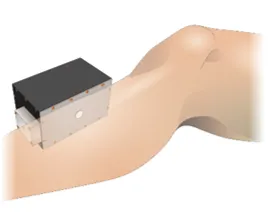New Methods to Assess Fluid Distribution in Muscle Tissue via Single Sided Magnetic Resonance Sensors
This invention is a portable and non-invasive magnetic resonance sensor that detects changes in intramuscular fluid volume status during hemodialysis or as a broader indicator of dehydration. This sensor facilitates real-time monitoring of fluid volume in human patients with conditions such as end-stage renal disease, congestive heart failure, and liver failure, to improve treatments and outcomes.
Researchers
-
devices and methods for assessment of fluid distribution in muscle tissue
European Patent Convention | Published application -
devices and methods for assessment of fluid distribution in muscle tissue
United States of America | Published application
Figures
Technology
This device is a portable magnetic resonance sensor that identifies changes in intramuscular fluid distribution by performing a non-invasive scan of skeletal muscle in the lower leg of human patients. To determine muscle hydration status, a RF excitation signal is emitted from the device. This RF excitation frequency can be tuned to acquire measurements at various tissue depths to enable spatial selection, with shorter RF excitation frequencies localizing measurements to deeper tissues. This sensor measures the multicomponent T2 decay signal produced from the targeted tissue and detects changes in hydration status through fluctuations in amplitude of multicomponent T2-based signal. The presence of subcutaneous fat can confound signals produced by muscle; however, the inventors have developed a diffusion-weighting algorithm to estimate the relative contribution of muscle and fat tissue to the hybrid signal. Thus, the multicomponent T2-based signal corresponding to muscle can be isolated. The magnetic resonance signal produced by muscle changes as a function of hydration status. Therefore, measurements of muscle can be collected over time to detect shifts in tissue fluid distribution with high sensitivity to improve patient outcomes in medical procedures that require removal of excess fluid.
Problem Addressed
Fluid volume overload (hypervolemia) indicates progression of various medical conditions, including end-stage renal disease, congestive heart failure, and liver failure. To remove excess fluid via hemodialysis, clinical staff require accurate measurements of fluid volume to ensure that nonessential fluid is removed, while proper hydration of the patient is maintained. Current methods of evaluating hydration status include measuring blood pressure and body weight, neither of which accurately determine hydration status of muscle, which is the primary fluid reservoir in the body. Without a precise measurement of hydration status, too much fluid may be removed during hemodialysis, leading to intradialytic hypotension. Intradialytic hypotension causes nausea, vomiting, cramping, and chest pain, and, ultimately, can increase the risk of morbidity from bowel ischemia, stroke, and myocardial infarction.
This technology is a single-sided magnetic resonance sensor that precisely monitors intramuscular fluid volume changes through a novel approach combining multicomponent T2 relaxometry, measurement localization via radio frequency (RF) excitation tuning, and diffusion weighting by varying echo time. This sensor facilitates safer removal of excess fluid to improve the quality of life and outcomes of patients with conditions associated with hypervolemia.
Advantages
- Low cost, high sensitivity platform
- Portable, non-invasive device enables ease of use for clinical staff
- Provides real-time measurements of intramuscular fluid distribution to improve medical procedures such as hemodialysis
License this technology
Interested in this technology? Connect with our experienced licensing team to initiate the process.
Sign up for technology updates
Sign up now to receive the latest updates on cutting-edge technologies and innovations.
